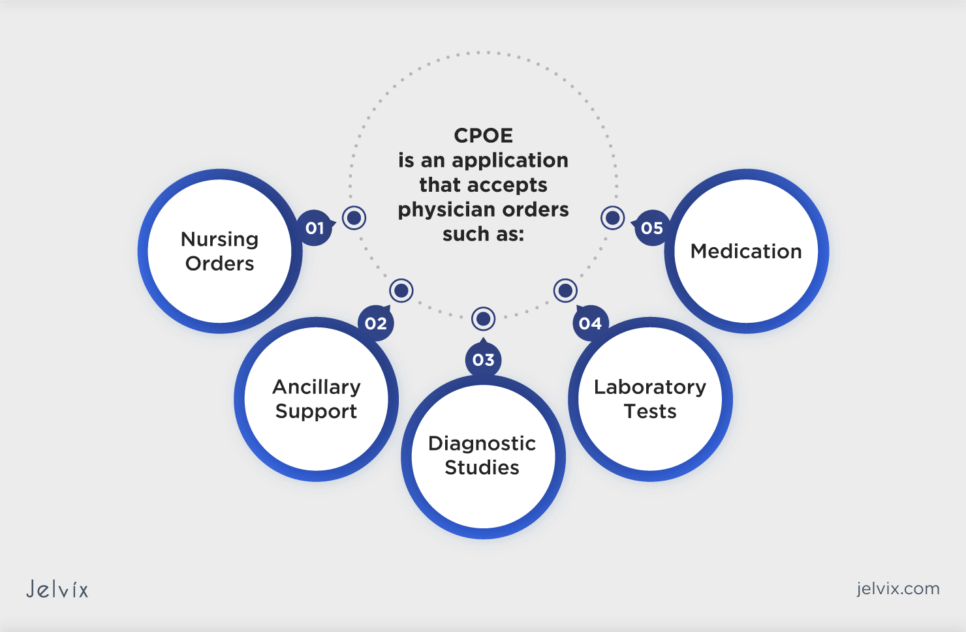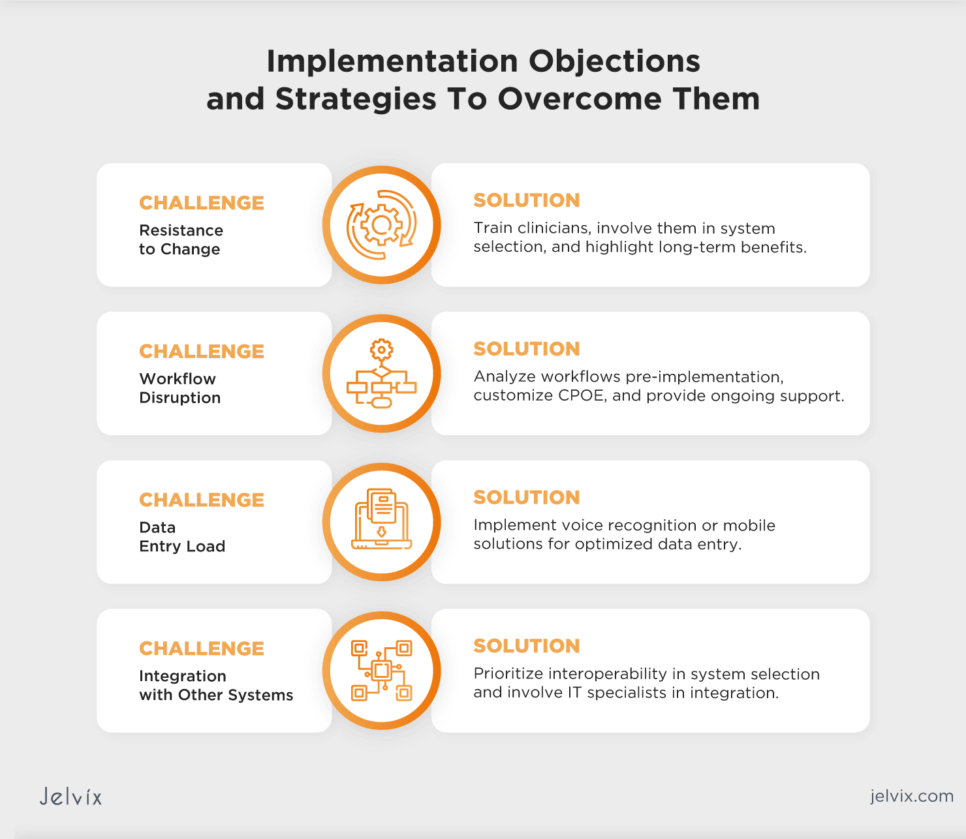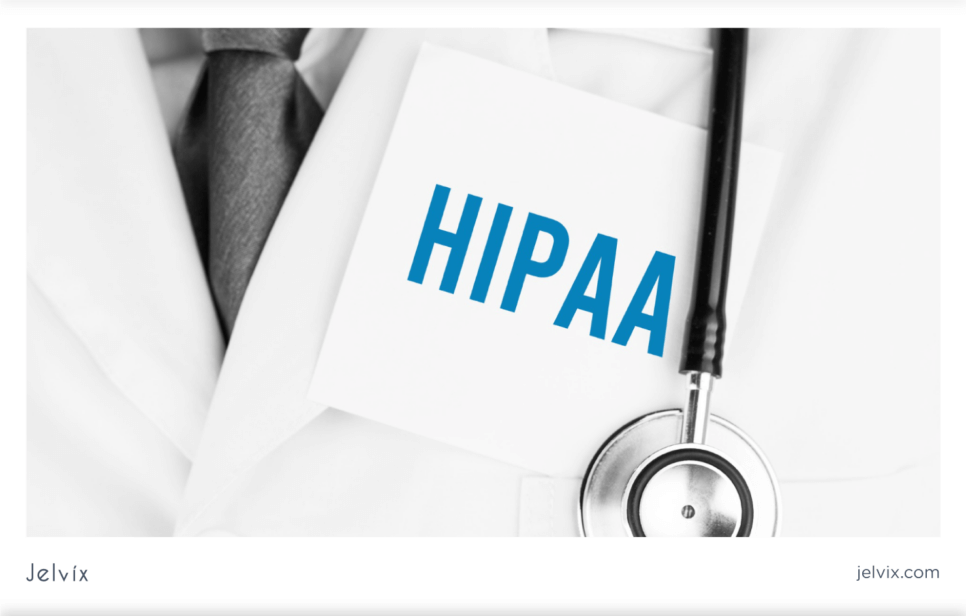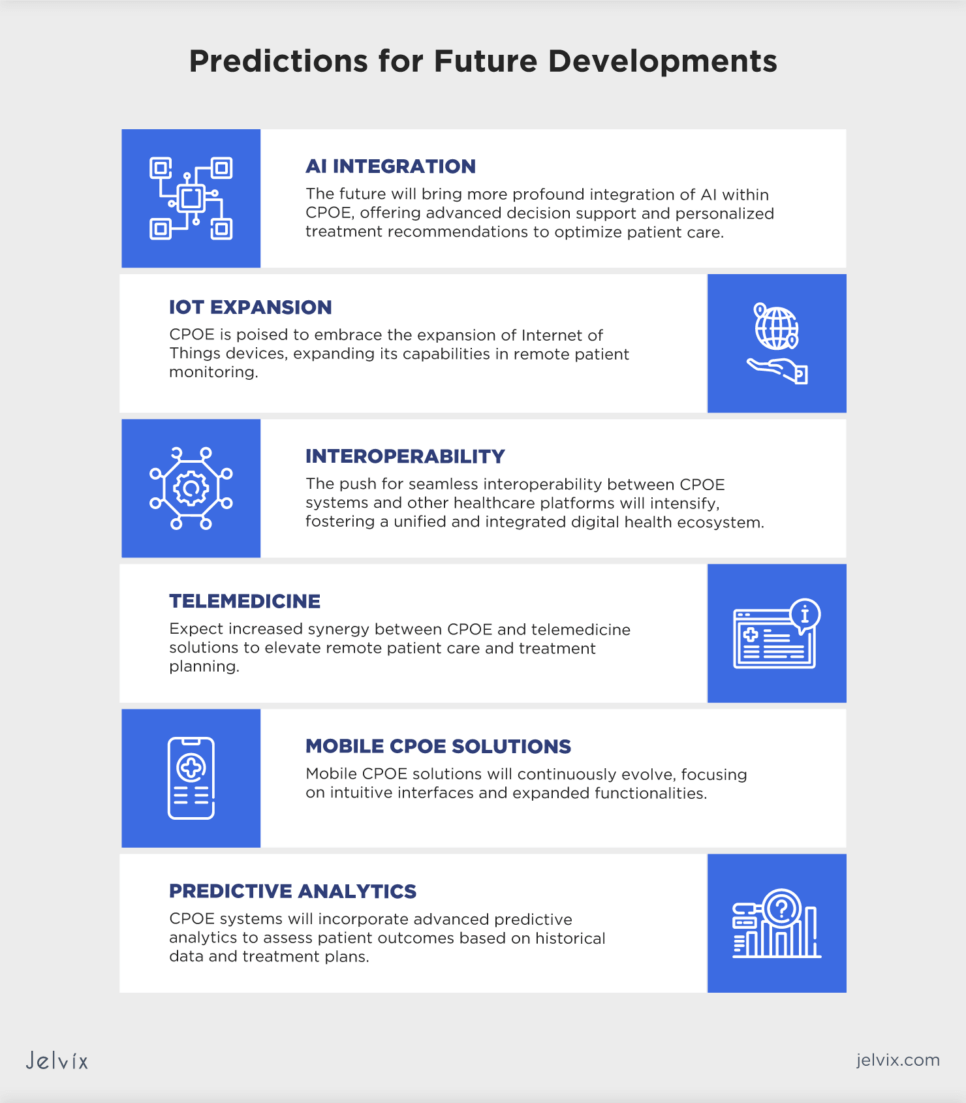Digitalization is transforming the medical industry, with the latest technologies accelerating this trend. A decade ago, paper-based prescriptions were the norm for doctors, but now, CPOE systems handle 85% of inpatient medication orders, streamlining healthcare procedures.
While CPOE enhances workflow for healthcare professionals, its integration remains a complex task requiring a deep understanding of healthcare systems.
In this article, the Jelvix team explores the role of CPOE in modern healthcare, addressing challenges, suggesting solutions, and diving into future predictions. Keep reading to learn how to seamlessly integrate CPOE into your existing systems while maintaining regulatory compliance.
What Is CPOE?
CPOE, or Computerized Provider Order Entry, is a digital system that enables healthcare professionals to electronically input and manage patient care orders. These orders can encompass medication prescriptions, laboratory tests, imaging studies, and other data that contribute to a patient’s treatment plan.
CPOE systems operate within an integrated healthcare information infrastructure. They allow authorized users, primarily clinicians, to enter medical orders directly into the system. These orders are then electronically transmitted to relevant departments, reducing reliance on traditional paper-based methods.
The Importance of CPOE Workflow in Healthcare
The CPOE market, valued at USD 1.5 billion in 2021, is projected to reach USD 2.7 billion by the year 2030. As digitalization evolves, CPOE stands out as a transformative force, revolutionizing the way clinical operations are conducted. Contrasting with outdated paper-based ordering, CPOE solutions bring numerous advantages.
Streamlining Workflow and Improving Efficiency
The implementation of CPOE systems has a transformative impact on healthcare workflows. It fosters efficiency and enhances overall operational effectiveness in numerous ways:
- Automated order entry: healthcare professionals can rapidly enter and process orders, reducing the risk of errors;
- Real-time order processing: it enhances communication among healthcare teams, reducing delays in care delivery and ensuring swift response to critical medical needs;
- Order tracking: CPOE systems provide real-time tracking of orders and updates on their status;
- Integration with EHR: streamlined access to comprehensive patient records accelerates decision-making and reduces duplicate data entry;
- Reduction in paper-based processes: the transition to digital processes reduces administrative load and minimizes the risk of lost or misplaced documents.
Enhancing Patient Safety and Reducing Errors
Speaking about the adoption of CPOE, nursing staff — almost 90% — fully agree that the system should be implemented. Replacing handwritten prescriptions with precise digital order entry, CPOE significantly reduces the risk of medication errors, ensuring accurate treatment and reliability of prescribed medications.
The Role of CPOE in Clinical Decision Support
CPOE surpasses its role as a mere order-entry system and contributes to informed and evidence-based decision-making in healthcare.
By providing real-time insights based on collected statistical data, CPOE enables clinicians to make informed decisions promptly. This strategic integration of decision support systems ensures that clinicians navigate the complexities of patient care with enhanced insights, minimizing risks and maximizing positive outcomes.
Key Features of CPOE Systems
CPOE systems are sophisticated digital solutions designed to streamline and enhance the ordering process. They offer innovative features that help support advanced patient care delivery:
- Ordering: CPOE streamlines the process of ordering medications, tests, and procedures. It replaces traditional paper-based methods, reducing errors and enhancing efficiency;
- Patient safety: CPOE incorporates safety features to mitigate risks and errors. It includes functionalities such as allergy alerts, drug interaction checks, and dosage verifications;
- Decision support: CPOE provides real-time decision support by offering evidence-based recommendations and alerts. It assists healthcare professionals in making informed and patient-centered decisions;
- Portability: CPOE allows healthcare pros to access and manage patient orders and information from various locations. This enables clinicians to provide timely and coordinated care outside traditional settings;
- Management: CPOE facilitates efficient order management, tracking, and coordination. It enables healthcare professionals to oversee the entire order process, from entry to fulfillment;
- Billing: CPOE supports the integration of order-related financial processes. This includes automated billing for services reducing administrative burdens, minimizing errors, and ensuring accurate financial transactions.
CPOE Usability and User Interface
The UI and usability of CPOE systems are critical for seamless integration into healthcare workflows. A user-friendly interface ensures efficient order entry, reducing the risk of errors. Usability considerations prioritize a design that caters to the diverse needs of clinicians, enhancing overall user satisfaction and adoption.
Integration with EHRs
A well-performed integration of CPOE with EHR streamlines clinical workflows by eliminating redundancies in data entry. When a physician enters an order through CPOE, relevant data is instantly updated in the EHR. This enables healthcare professionals to make decisions based on up-to-date patient information. The integration also facilitates real-time access to patient information.
Decision Support and Alert Systems
Decision support systems embedded within CPOE provide real-time clinical guidance to healthcare professionals. These systems analyze patient data and offer evidence-based recommendations, assisting clinicians in making informed decisions about diagnostic tests, treatments, and prescriptions.
CPOE systems incorporate medication safety alerts to mitigate the risk of errors. These alerts notify healthcare professionals about potential drug interactions, allergies, or dosage issues, promoting safe prescribing practices.
Reporting and Analytics Capabilities
CPOE systems boast robust reporting and analytics capabilities, providing valuable insights into ordering patterns, system usage, and clinical decision trends. Administrators can leverage this data-driven approach to optimize system performance, identify areas for improvement, and ensure adherence to best practices.
Implementation Challenges and Strategies To Overcome Them
The implementation of CPOE may encounter technical and adoption challenges that require addressing to ensure a successful and smooth transition.
Resistance to Change
Healthcare professionals may resist transitioning from traditional order entry methods to CPOE due to familiarity and perceived disruption.
Implement comprehensive training programs, engage clinicians in the system selection process, and communicate the long-term benefits of improved efficiency, patient safety, and data accuracy.
Workflow Disruption
CPOE implementation may disrupt established workflows, causing temporary productivity challenges and potential resistance.
Conduct a thorough workflow analysis before implementation. Customize CPOE to fit existing processes, and provide ongoing support to address emerging issues during the transition period.
Data Entry Load
Clinicians may perceive data entry as time-consuming, leading to potential resistance and decreased efficiency.
Implement voice recognition or mobile solutions to ease data entry, streamline order sets, and provide adequate training to optimize the use of CPOE.
Integration with Other Systems
Difficulties in integrating CPOE with existing systems, such as EHRs, can impede seamless data flow and limit clinical interoperability.
Prioritize interoperability during system selection, involve IT specialists in the integration process, and ensure compatibility with existing healthcare infrastructure to facilitate smooth data exchange.
Technical Challenges
Technical issues, such as system downtime or slow response times, can hinder user confidence and satisfaction.
Conduct thorough testing before implementation, and establish rapid response protocols for technical issues to minimize downtime and maintain system reliability.
CPOE Integration: Assessing Organizational Readiness
The successful implementation of CPOE requires a comprehensive assessment of organizational readiness. Those seeking ways to integrate CPOE in their healthcare processes need to understand key considerations, such as staff training, technical challenges, financial issues, and regulatory aspects.
Training and Support for Healthcare Professionals
The optimal use of CPOE demands a skilled workforce. Insufficient or ineffective training programs can lead to user errors and frustration.
Explore targeted training initiatives tailored to healthcare professionals, coupled with robust ongoing support mechanisms. Develop comprehensive training programs tailored to different user roles and provide accessible resources, such as user manuals and tutorials, to support continuous learning.
Overcoming Technical and Financial Barriers
Successful CPOE adoption relies on overcoming technical challenges and financial constraints. Navigate the technical landscape strategically, aligning CPOE implementation with existing infrastructure. Address financial considerations with prudent planning, ensuring that the benefits of CPOE align with the organization’s budget.
Change Management and Cultural Considerations
CPOE implementation requires a cultural shift. Dive into effective change management strategies, emphasizing cultural adaptability. Foster an organizational culture that embraces technological innovation, tailoring workflows to seamlessly integrate CPOE to maximize its transformative potential.
Regulatory and Legal Aspects of CPOE
The implementation of CPOE in healthcare is subject to various regulatory and legal considerations:
- Health Insurance Portability and Accountability Act: HIPAA sets the standards for the protection of sensitive patient data. Healthcare organizations must ensure that CPOE systems comply with HIPAA regulations, safeguarding the confidentiality of patient information;
- Electronic Prescribing of Controlled Substances: EPCS falls under the purview of the Drug Enforcement Administration. CPOE systems must adhere to DEA guidelines when facilitating electronic prescriptions for controlled substances to prevent misuse and ensure traceability;
- Clinical Decision Support Rules: the Center for Medicare & Medicaid Services has established regulations related to CDS. Healthcare organizations must align CPOE systems with CMS rules to ensure accurate and meaningful clinical decision support;
- Food and Drug Administration Regulations: the FDA may regulate certain aspects of CPOE systems, particularly those involving medical devices. To ensure safety and efficacy, healthcare organizations must comply with FDA regulations if the CPOE system involves using medical devices;
- Data security laws: various data security and privacy laws exist at the federal and state levels. CPOE systems must comply with these laws to protect patient data from unauthorized access or breaches.
Note that some states and countries may have specific regulations governing the use of CPOE. Healthcare organizations must be aware of and comply with them to ensure that CPOE practices align with local legal requirements.
Read more about the role of app development companies in medical diagnostics.
Compliance with Healthcare Regulations and Standards
Ensuring compliance with healthcare regulations and standards is a fundamental aspect of implementing CPOE.
Data Privacy and Security Concerns
By addressing data privacy and security concerns, healthcare organizations can establish a robust framework for CPOE implementation that prioritizes patient data protection and mitigates cybersecurity risks:
- Patient data encryption: CPOE involves the electronic transmission of sensitive patient information, making encryption a critical aspect. Employ advanced encryption protocols to secure patient data during transmission;
- Access controls and user authentication: unauthorized access poses a significant threat to data privacy. Implement multi-factor authentication and role-based access controls;
- Security audits: continuous monitoring of data access and system vulnerabilities is essential but can be resource-intensive. Invest in automated security audit tools that provide real-time alerts for suspicious activities;
- Cyber threats protection: healthcare organizations may struggle to keep pace with emerging cyber threats. Collaborate with cybersecurity experts to stay informed about the latest hazards and threat detection systems;
- Secure data storage: data breaches or loss of critical information due to insufficient backup measures pose significant risks. Utilize secure cloud storage with encryption features and implement regular data backup routines to prevent data loss;
- User training: insufficient training and awareness among healthcare professionals can heighten this risk of cyber attacks. Conduct regular training sessions and educate healthcare pros about phishing attempts, password security, and the importance of data protection.
Legal Implications and Responsibilities
Addressing legal implications and responsibilities will help healthcare organizations navigate the complex legal environment associated with CPOE implementation:
- Liability issues: inaccuracies in electronic orders or misinterpretation of digital information can lead to legal consequences. Establish clear protocols for reporting and investigating errors and create a transparent system to communicate mistakes and their resolutions;
- Informed consent: physicians must ensure patients are well-informed about CPOE technology. Develop detailed procedures, covering electronic order processing, data security, and patients’ rights for digital health records;
- Legal framework: regularly review and update CPOE practices to align with changing legal requirements. Engage in ongoing education for healthcare professionals to keep them informed about legal responsibilities;
- Patient privacy rights: CPOE involves electronic processing of patient data, raising concerns about privacy rights. Implement robust data privacy measures, including encryption, access controls, and audit trails, to protect patient privacy;
- Regulatory compliance: establish a compliance management program that includes regular audits, updates, and staff training. Collaborate with legal experts to interpret and apply regulations effectively.
Impact of CPOE on Healthcare Outcomes
Ensuring compliance with healthcare regulations and standards through the implementation of CPOE systems has a direct and positive impact on healthcare outcomes:
- Regulatory adherence: adhering to regulations safeguards patient confidentiality and data integrity, preventing unauthorized access and ensuring compliance with legal standards;
- Data privacy and security: CPOE systems prioritize robust security measures to protect patient information from unauthorized access, breaches, and cyber threats;
- Legal responsibilities: CPOE aids healthcare professionals in meeting legal obligations for precise and timely patient care documentation;
- Auditable records: CPOE generates comprehensive, auditable records of all healthcare transactions and interactions, contributing to transparency and accountability;
- Standardization: CPOE promotes standardized practices following established clinical guidelines and protocols ensuring consistency in care delivery;
- Quality reporting: CPOE often includes features for quality reporting, enabling healthcare organizations to measure and report on their compliance with healthcare quality standards.
CPOE in Numbers: Case Studies and Reports
To understand the real impact of CPOE on healthcare delivery and evaluate its integration necessity into your organizational processes, we recommend delving into cases and reports highlighting CPOE efficiency.
Measuring the Impact of CPOE on Patient Care and Safety
A 2023 case study by the Journal of Education and Health Promotion evaluated the impact of CPOE on the chemotherapy process and medication errors. The study indicates detecting 46% of medication errors and 66% of problem orders in 80 paper-based chemotherapy prescriptions before implementing CPOE. After its implementation, they detected 9% of medication errors and 7% of problem orders in 80 CPOE prescriptions. It means that CPOE contributed to reducing medication errors by 37% and problematic orders by 59%.
An earlier study, conducted by the Journal of the American Medical Informatics Association in 2016, examined the impact of CPOE on improving medical errors in intensive care units. The report showed that the shift from paper-based ordering to commercial CPOE systems in ICUs was associated with an 85% decrease in medication prescribing error rates and a 12% decline in ICU mortality rates.
Another report by the National Library of Medicine stated that using CPOE for medication infusions in a pediatric ICU demonstrated significant efficiency advantages over the handwritten method. The CPOE contained only 4% of errors, while the handwritten method had 73%. Notably, none of the errors in the CPOE group were categorized as ‘high-risk,’ contrasting with 25% of handwritten errors being deemed ‘high-risk.’
In summary, multiple studies underscore the significant efficiency and safety advantages of CPOE in healthcare settings. When integrated properly, it can become a life-saver in your healthcare settings.
Cost-Benefit Analysis of CPOE Implementation
CPOE is a complex system that requires time and financial resources. The costs associated with its implementation can be divided into three parts: initial Investment, yearly maintenance, and implementation duration.
Initial Investment
The upfront costs of installing a CPOE include expenses for software acquisition, hardware infrastructure, training programs, and potential disruptions during implementation.
The initial investment serves as a foundation for long-term benefits. The implementation can be rolled out gradually, mitigating immediate financial burdens and allowing for a phased approach.
Yearly Maintenance Costs
Annual maintenance costs of CPOE can add hundreds of thousands of dollars to the total expense. This includes ongoing support, software updates, and system optimization. However, yearly maintenance costs contribute to system sustainability, ensuring that the CPOE remains effective and aligned with evolving healthcare needs.
Duration of Implementation
The time it takes to implement CPOE can be extended significantly depending on the complexity of the system. A gradual rollout can pose challenges in terms of time efficiency and immediate returns on investment. However, a phased implementation allows healthcare organizations to manage the transformation gradually, minimizing disruptions and optimizing the system as it evolves.
If you are unsure about the necessity of implementing CPOE in your healthcare organization and seek advice, contact our experts. They will be happy to answer all your questions and help you make an informed decision about your future healthcare solution.
Integration with Emerging Technologies
The evolution of CPOE includes seamless integration with technologies that allow for enhanced functionalities and improved healthcare delivery.
Artificial Intelligence Integration
CPOE, when correctly integrated with AI, amplifies its capabilities. AI augments clinical decision support within CPOE, providing real-time insights, predictive analytics, and personalized recommendations. The synergy enhances the precision and efficiency of medical orders, contributing to improved patient outcomes and streamlined workflows.
Internet of Things Synergy
CPOE’s integration with IoT introduces a new dimension to healthcare connectivity. IoT devices, such as wearable health monitors, seamlessly communicate with CPOE systems, offering real-time patient data. This connection fosters a proactive approach to healthcare, enabling clinicians to make data-driven decisions and enhancing the overall quality of care.
The Role of CPOE in Telemedicine and Remote Care
CPOE facilitates seamless integration between healthcare professionals and patients in virtual environments. It enables clinicians to digitally prescribe medications, order diagnostic tests, and create comprehensive care plans for remote patients. CPOE’s robust features ensure accurate and efficient transmission of medical orders, promoting timely interventions and coordinated care.
Predictions for Future Developments
By envisioning future developments, healthcare organizations can prepare for an interconnected, intelligent, and patient-centric approach to using CPOE:
- AI Integration: the future will bring deeper integration of AI within CPOE, offering advanced decision support and personalized treatment recommendations to optimize patient care;
- IoT expansion: CPOE is poised to embrace the expansion of Internet of Things devices, expanding its capabilities in remote patient monitoring;
- Interoperability: the push for seamless interoperability between CPOE systems and other healthcare platforms will intensify, fostering a unified and integrated digital health ecosystem;
- Telemedicine: expect increased synergy between CPOE and telemedicine solutions to elevate remote patient care and treatment planning;
- Mobile CPOE solutions: mobile CPOE solutions will undergo continuous evolution, with a focus on intuitive interfaces and expanded functionalities;
- Predictive analytics: CPOE systems will incorporate advanced predictive analytics to assess patient outcomes based on historical data and treatment plans.
How Jelvix Can Facilitate CPOE Integration
CPOE is a powerful tool that helps reduce medication errors and enhance patient care. Seamless integration with EHR and CDS systems is crucial to provide doctors with comprehensive patient data for improved care and quicker responses.
At Jelvix, we understand the role of CPOE in contributing to the efficiency and accuracy of medication ordering in healthcare facilities. That’s why we offer our expertise and datastack technologies to help you explore the seamless integration of CPOE systems with broader healthcare software development initiatives.
In case you need a consultation on CPOE integration into your healthcare environment, we are here to help. Our experts are free to answer all your questions.
Need a qualified tech partner?
Leverage a dedicated team of professionals exclusively for your project.















